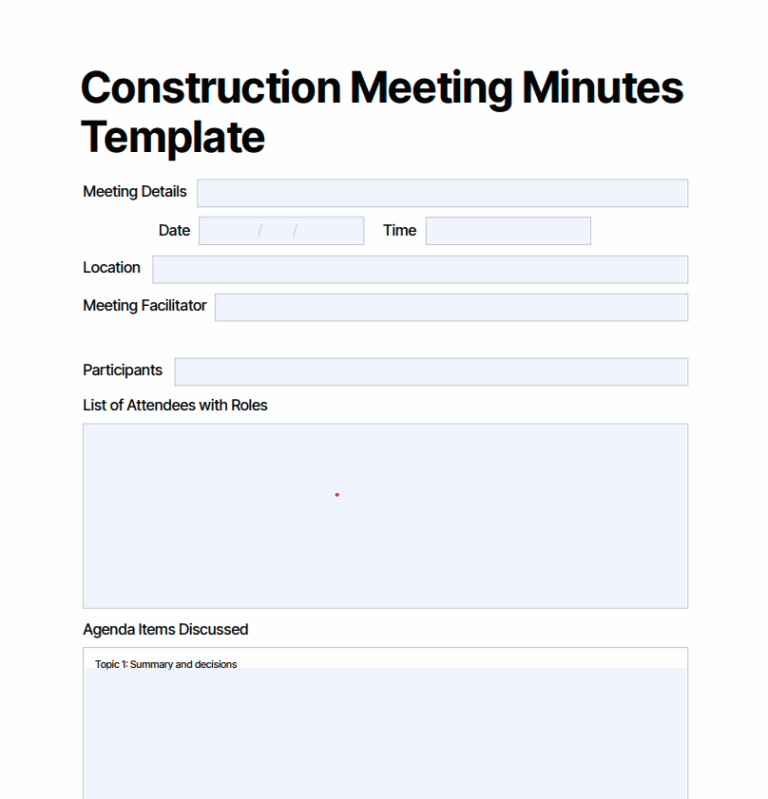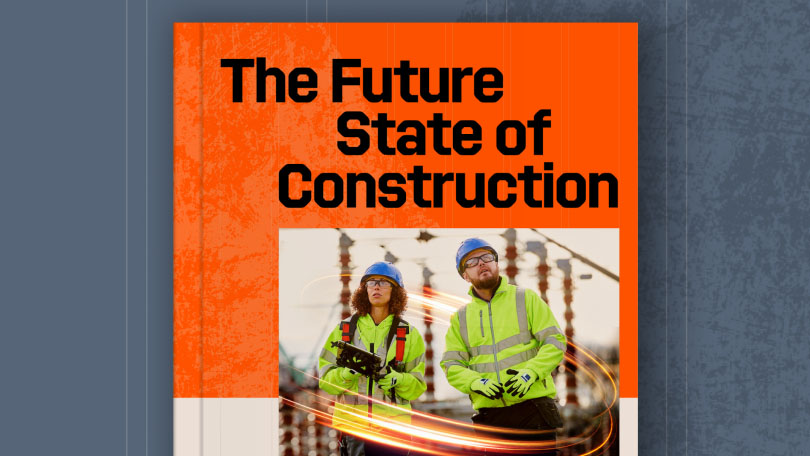— 5 min read
Construction Meeting Minutes Template: (Guide & Free Download)


Last Updated Aug 28, 2025

Nicholas Dunbar
Content Manager
62 articles
Nick Dunbar oversees the creation and management of UK and Ireland educational content at Procore. Previously, he worked as a sustainability writer at the Building Research Establishment and served as a sustainability consultant within the built environment sector. Nick holds degrees in industrial sustainability and environmental sciences and lives in Camden, London.

Zoe Mullan
27 articles
Zoe Mullan is an experienced content writer and editor with a background in marketing and communications in the e-learning sector. Zoe holds an MA in English Literature and History from the University of Glasgow and a PGDip in Journalism from the University of Strathclyde and lives in Northern Ireland.
Last Updated Aug 28, 2025

Construction meetings help contractors share information with other stakeholders and get ideas on driving the project forward. To reap all the benefits from construction meetings, project managers need to be able to keep a detailed and accurate record of who participated in the meeting, what topics were discussed and any decisions that were made.
Recording meeting minutes can help capture all these ideas in a compact and easy-to-understand format. Using a template to keep meeting minutes can help establish a record of the meeting efficiently and in a standard format so that anyone on the team can easily reference and understand what happened.
This article will go over all the benefits of establishing and using a meeting minutes template to help improve communication and collaboration between construction stakeholders.
Table of contents
Understanding Construction Meeting Minutes Templates
A construction meeting minutes template is a pre-formatted document—usually a one- or two-page form—that guides the note-taker through every agenda item, decision and follow-up action agreed onsite or in the site office. By giving teams a consistent framework, the template prevents missed details, accelerates distribution, and creates an auditable trail that aligns with quality-management systems such as ISO 9001.
Why is it Important to Use a Meeting Template?
Meeting minutes act as a record and a reference point for meeting discussions. Using a template can streamline note-taking and help make minutes clearer and more usable for all stakeholders, so that everyone understands meeting outcomes in the same way.
Here are some of the reasons a template can be important to creating meeting minutes.
- Streamlined note-taking: Ticking pre-set boxes is faster than writing free-form notes.
- Consistent records: Identical structure across projects lets stakeholders skim and compare minutes in seconds.
- Enhanced communication: Clear, shared language reduces disputes and clarifies next steps.
- Progress tracking: Numbered action items with due dates surface stalled tasks early.
- Accountability & audit: Sign-off fields give a legally defensible record should claims arise under HGCRA 1996.
- Time savings: Reusable forms cut admin hours and printing costs.
What to Include in Construction Meeting Minutes
Before establishing a template for construction meeting minutes, project teams have to decide exactly what information they’ll include. Key administrative facts to include are the names and roles of attendees, the meeting’s agenda (tie stages to the RIBA Plan of Work if applicable), any decisions made during the meeting, actions and any associated deadlines.
Having these facts included in the written record helps improve transparency and accountability on those actions, which helps to ensure improvement and forward movement on them.
A construction meeting minutes template is a standardised, structured document that construction teams can use to record what happens during construction meetings. Here are some of the things that should be included in a template.
- Meeting title, project reference, date, start/finish time and location
- Attendee list with names, roles and companies
- Agenda items (numbered)
- Discussion summary and decisions taken (with rationale)
- Action items: owner, due date, status
- Commercial impacts (cost, programme)
- Next meeting date/time
Free Download
Construction Meeting Minutes Template
This free editable PDF template has all the fields to get started creating a standardised set of meeting minutes for any construction project.
- Easy-to-use editable PDF
- Ready-to-use across multiple projects
- Trusted by construction professionals


Improving Your Meeting Minutes
One of the main barriers to keeping and sharing meeting minutes effectively is compiling all the necessary information. There needs to be a designated meeting attendee keeping careful notes, which then need to be made into something more readable after the meeting. They also need to be sent out to relevant stakeholders for use and reference. Additionally, using cloud-based systems can make it easier for teams to access and share the minutes with everyone on the team.
To enhance the effectiveness of meeting minutes, consider the following.
Use Tools & Software
There are digital tools and software designed to standardise agenda creation and minute-taking to maximise both efficiency and accuracy in the process, especially if you’re already leveraging BIM workflows for coordination
Create Best Practices
Implement consistent methods for note taking and writing, organising and storing meeting minutes, and communicate these practices to the team.
Regularly Review Minutes
Meeting minutes are meant to be used as records of project progress. Teams may benefit from regular review and analysis of meeting minutes to identify trends, issues and opportunities for improvement.
Using Templates to Increase Efficiency and Usability of Meeting Minutes
Using a construction meeting minutes template can help keep effective records of meeting decisions and action steps that can help keep a project on track. Templates put meeting minutes into a standard format, making it easier to take down pertinent points.
Templates also make sure everyone knows what’s going on, reducing the chances of mix-ups and helping avoid disputes.
Construction teams can use digital tools to make the whole process quicker and more organised. In the end, these templates not only help manage projects better but also make sure things run smoothly and successfully in the construction sector.
Where to Find Free, Downloadable Templates
- Procore Library: Editable PDF tailored to UK projects; includes BS 1192 compliance fields.
- Smartsheet Gallery: Google-Sheet version with built-in reminders.
Tip: Save the PDF to your cloud drive, convert to a live form and share the link with the team.
Choosing the Right Format
| Format | Best For | Watch-outs |
| Excel | Complex formulas and filters | Version control chaos in email threads |
| Locking layout, on site tablets | Harder to bulk-edit later | |
| Cloud forms (e.g., Procore Forms tool) | Real-time collaboration and audit trail | Requires stable internet |
Categories:
Written by

Nicholas Dunbar
Content Manager | Procore
62 articles
Nick Dunbar oversees the creation and management of UK and Ireland educational content at Procore. Previously, he worked as a sustainability writer at the Building Research Establishment and served as a sustainability consultant within the built environment sector. Nick holds degrees in industrial sustainability and environmental sciences and lives in Camden, London.
View profile
Zoe Mullan
27 articles
Zoe Mullan is an experienced content writer and editor with a background in marketing and communications in the e-learning sector. Zoe holds an MA in English Literature and History from the University of Glasgow and a PGDip in Journalism from the University of Strathclyde and lives in Northern Ireland.
View profileExplore more helpful resources

Construction Management Contracts: A Complete UK Guide
Managing construction contracts can lead to an extensive physical paper trail. Sharing contracts, getting signatures and managing timelines is difficult when teams and clients are scattered across job sites and...

Key Differences Between Contractors & Subcontractors
In UK commercial construction, main (or principal) contractors engage directly with project owners to deliver complete construction programmes, while subcontractors perform specific scopes of work under the main contractor’s management....

The Role of RFPs in UK Construction Projects
Requests for Proposals (RFPs) are a core document for construction procurement in the United Kingdom. Effective RFPs align expectations, establish clear evaluation criteria, and create accountability between clients and contractors....

Financial Management in Construction Projects
Effective financial management can make or break construction projects. Teams that master budgeting, cash flow and cost control are better positioned to deliver projects on time, within budget and with...
